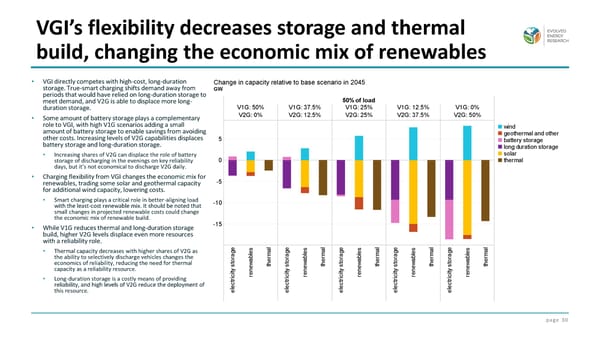page 30 • VGI directly competes with high-cost, long-duration storage. True-smart charging shifts demand away from periods that would have relied on long-duration storage to meet demand, and V2G is able to displace more long- duration storage. • Some amount of battery storage plays a complementary role to VGI, with high V1G scenarios adding a small amount of battery storage to enable savings from avoiding other costs. Increasing levels of V2G capabilities displaces battery storage and long-duration storage. • Increasing shares of V2G can displace the role of battery storage of discharging in the evenings on key reliability days, but it’s not economical to discharge V2G daily. • Charging flexibility from VGI changes the economic mix for renewables, trading some solar and geothermal capacity for additional wind capacity, lowering costs. • Smart charging plays a critical role in better-aligning load with the least-cost renewable mix. It should be noted that small changes in projected renewable costs could change the economic mix of renewable build. • While V1G reduces thermal and long-duration storage build, higher V2G levels displace even more resources with a reliability role. • Thermal capacity decreases with higher shares of V2G as the ability to selectively discharge vehicles changes the economics of reliability, reducing the need for thermal capacity as a reliability resource. • Long-duration storage is a costly means of providing reliability, and high levels of V2G reduce the deployment of this resource. VGI’s flexibility decreases storage and thermal build, changing the economic mix of renewables
 Exploring the Value of Vehicle to Grid (V2G) for California Page 29 Page 31
Exploring the Value of Vehicle to Grid (V2G) for California Page 29 Page 31